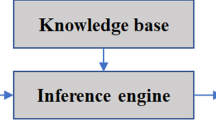Abstract
A learning method for neuro-fuzzy systems is proposed that includes processes of architecture evolution, membership function self-learning, and synaptic weights adjustment. This method provides fast response and on-line information processing with the simultaneous adaptation of the system structure and parameters to problem conditions.
Similar content being viewed by others
References
J.-S. Jang, C.-T. Sun, and E. Mizutani, Neuro-Fuzzy and Soft Computing: A computational Approach to Learning and Machine Intelligence, Prentice Hall, Upper Saddle River (1997).
L. Rutkowski, Computational Intelligence: Methods and Techniques, Springer, Berlin–Heidelberg (2008).
R. Kruse, C. Borgelt, F. Klawonn, C. Moewes, M. Steinbrecher, and P. Held, Computational Intelligence, Springer, Berlin (2013).
K.-L. Du and M. N. S. Swamy, Neural Networks and Statistical Learning, Springer, London (2014).
T. Takagi and M. Sugeno, “Fuzzy identification of systems and its applications to modeling and control,” IEEE Trans. on Systems, Man, and Cybernetics, 15, 116–132 (1985).
S. Haykin, Neural Networks: A Comprehensive Foundation, Prentice Hall, Inc., Upper Saddle River, N.J. (1999).
L. Ljung, System Identification: Theory for the User, Prentice Hall, Inc., Upper Saddle River (1987).
O. Nelles, Nonlinear System Identification, Springer, Berlin (2001).
J. Friedman, T. Hastie, and R. Tibshirani, The Elements of Statistical Learning: Data Mining, Inference, and Prediction, Springer, Berlin (2003).
N. Kasabov, “Evolving fuzzy neural networks — algorithms, applications, and biological motivation,” in: T. Yamakawa and G. Matsumoto (eds.), “Methodologies for the Conception, Design, and Application of Soft Computing.” World Scientific, Singapore (1998), pp. 271–274.
N. Kasabov, “Evolving fuzzy neural networks: Theory and applications for on-line adaptive prediction, decision making, and control,” Australian J. of Intelligent Information Processing Systems, 5(3), 154–160 (1998).
N. Kasabov, “Evolving fuzzy neural network for on-line supervised/unsupervised, knowledge-based learning,” IEEE Trans. on Man, Machine, and Cybernetics, 31, No. 6, 902–918 (2001).
N. Kasabov, Evolving Connectionist Systems, Springer, London (2003).
E. Lughofer, Evolving Fuzzy Systems — Methodologies, Advanced Concepts and Applications, Springer, Berlin (2011).
Ye. Bodyanskiy, I. Pliss, and O. Vynokurova, “Flexible neo-fuzzy neuron and neuro-fuzzy network for monitoring time series properties,” Information Technology and Management Science, 16, 47–52 (2013).
Ye. Bodyanskiy, I. Pliss, and O. Vynokurova, “Flexible wavelet-neuro-fuzzy neuron in dynamic data mining tasks,” Oil and Gas Power Engineering, 2(20), 158–162 (2013).
L.-X. Wang and J. M. Mendel, “Fuzzy basis functions, universal approximation and orthogonal least squares learning,” IEEE Trans. on Neural Networks, 3, 807–814 (1993).
T. Kohonen, Self-Organizing Maps, Springer, Berlin (1995).
Ye. Bodyanskiy, V. Kolodyazhniy, and A. Stephan, “An adaptive learning algorithm for a neuro-fuzzy network,” in: B. Reusch (ed.), “Computational Intelligence: Theory and Applications,” Springer, Berlin–Heidelberg–New York (2001), pp. 68–75.
P. Otto, Ye. Bodyanskiy, and V. Kolodyazhniy, “A new learning algorithm for a forecasting neuro-fuzzy network,” Integrated Computer-Aided Engineering, 10, No. 4, 399–409 (2003).
K. S. Narendra and K. Parthasarathy, “Identification and control of dynamical systems using neural networks,” IEEE Trans. on Neural Networks, 1, 4–26 (1990).
Author information
Authors and Affiliations
Corresponding author
Additional information
Translated from Kibernetika i Sistemnyi Analiz, No. 4, pp. 13–18, July–August, 2015.
Rights and permissions
About this article
Cite this article
Bodyanskiy, Y.V., Boiko, O.O. & Pliss, I.P. Adaptive Method of Hybrid Learning for an Evolving Neuro-Fuzzy System. Cybern Syst Anal 51, 500–505 (2015). https://doi.org/10.1007/s10559-015-9741-x
Received:
Published:
Issue Date:
DOI: https://doi.org/10.1007/s10559-015-9741-x




